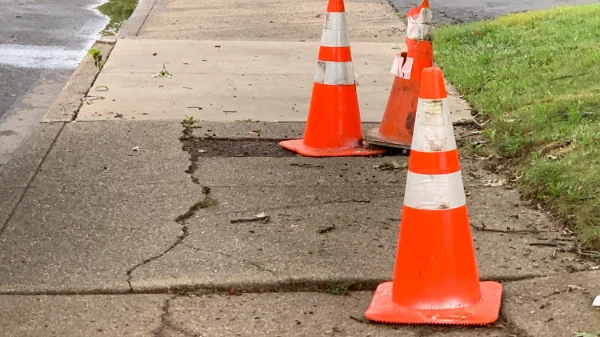On June 11, 2023, a tanker truck caught fire in Northeast Philadelphia, killing its driver and devastating over 100 feet of Interstate 95 above it. In the hours following, local and national news speculated that with one of the nation’s busiest thoroughfares decommissioned for months, “commuter chaos“ would ensue. Now that over two weeks have passed, the media’s predictions not only appear overblown, but Philadelphia is seizing the wake of disaster to reconsider dependency on the highway altogether.
By some estimates, the I-95 supports up to 160,000 trips daily. These include a mix of local and interstate travel shared between trucks and commuters, the latter of which have alternatives, like local routes and transit, available at their discretion. The evening of June 11, the region’s transit agency, SEPTA, fortified one of those alternatives by adding staff, service, and rail cars to the three routes serving the areas impacted by the severed expressway.
People made the switch. According to SEPTA, ridership jumped 12% June 12 on those three Regional Rail lines compared to June 5. The agency took this as a sign that people were leaning on transit and is currently figuring out how to sustain the increased capacity.
The week of the collapse also welcomed an unprecedented embrace of new rail, namely the Roosevelt Boulevard Subway. Councilmember Mike Driscoll, whose constituency is directly impacted by the collapse, introduced a resolution on June 15 calling for funding to study the subway, scheduling public hearings, and working with SEPTA and state officials to move the project forward.
“We believe that if a Roosevelt Boulevard subway had been in place, the shock of I-95 would have been much more tame compared to what it is now for our commuters,” his legislative director told Billy Penn. Evidently, he wasn’t the only one who thought so, as the Philadelphia City Council unanimously passed the resolution.
The subway’s roots actually stretch back over a century, but the project fell to the wayside in the intervening years, leaving a neighborhood built with rail in mind defined instead by one of the city’s most dangerous arterials: Roosevelt Boulevard. In 2018, the road witnessed 21% of the city’s fatal crashes and its reputation hasn’t improved much since.
I-95 detours thrusted hundreds of commuters onto the boulevard, a choice many Philadelphians would’ve avoided if they had an alternative, according to Jay Arzu, a PhD student at the University of Pennsylvania. Arzu is one of Roosevelt Boulevard Subway’s strongest and most prominent champions, evidenced in part by his Twitter account focused on advocacy for the subway. His diligence on- and offline is credited with spawning the movement, which gained additional traction through YouTuber Alan Fisher, as well as t-shirts exclaiming, “Build the Roosevelt Boulevard Subway!” available through 5th Square.
Now, it’s culminated in explicit political support within Philadelphia’s City Council. In an interview with Penn Today, Arzu expressed hope that, with transit in the spotlight, the city and broader public will additionally scrutinize highway spending. “I don’t want to fully criticize I-95 but at the same time we’ve seen the commonwealth and PennDOT throw money at the I-95 modernization project and it’s years over budget and hasn’t even gotten to Phase Two. It’s scary how much money they’ve thrown at this,” he told Penn Today. “We throw money at the roads and shortchange public transportation systems and authorities.”
To many, Pennsylvania Governor Josh Shapiro’s disaster declaration and the livestream of the I-95 rebuild exemplify these priorities. "To expedite the rebuilding of I-95 and cut through the red tape, this morning, I issued a disaster declaration, allowing the Commonwealth to immediately draw down federal funds and move quickly to begin the repair and reconstruction process," said Shapiro on June 12. Nine days later, he announced the I-95 would open by the weekend.
His declaration freed up $7 million in state aid, which joined President Biden’s pledge to fully absorb the costs of reconstruction. Advocates couldn’t help but fantasize about comparable fanfare for transit-oriented projects. “Can we get the same commitment and urgency to cut through the red tape for transit improvements directly related to the outage?” 5th Square Advisory Board Member Michael Noda asked.
His question didn’t go unanswered. “SEPTA is stepping up to support our community — we must ensure they have the resources they need,” tweeted Congresswoman Madeleine Dean alongside a letter urging Transportation Secretary Pete Buttigieg to fund SEPTA using Emergency Relief funds. The letter—whose signatories include Senator John Fetterman, Senator Bob Casey, and Congressman Dwight Evans—came days before a rally in Pennsylvania's capital for diversifying funding streams for SEPTA. It also joins SEPTA General Manager Leslie Richards’ anxieties that, “if a disaster like this happened next year, SEPTA wouldn’t be able to handle it unless it gets more funding”
Whether new avenues of funding the cash-strapped agency will ultimately open remains to be seen, but it’s unquestionable that all eyes are on its potential to better serve an area that was constructed with car ownership in mind, but not car dependency.


.webp)

.webp)
